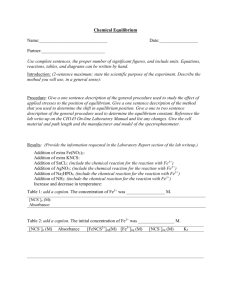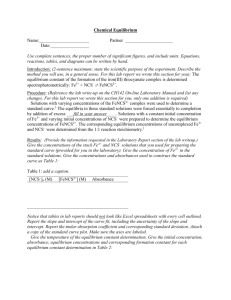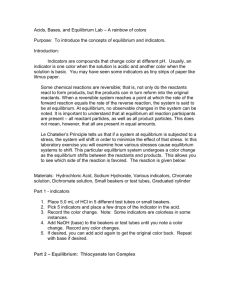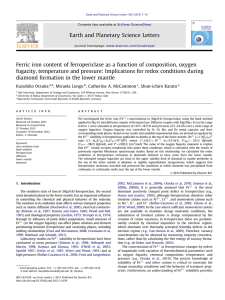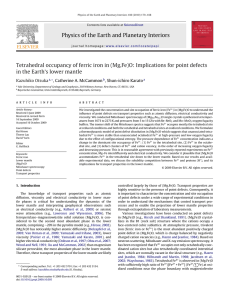Experiment 1: Report form
advertisement
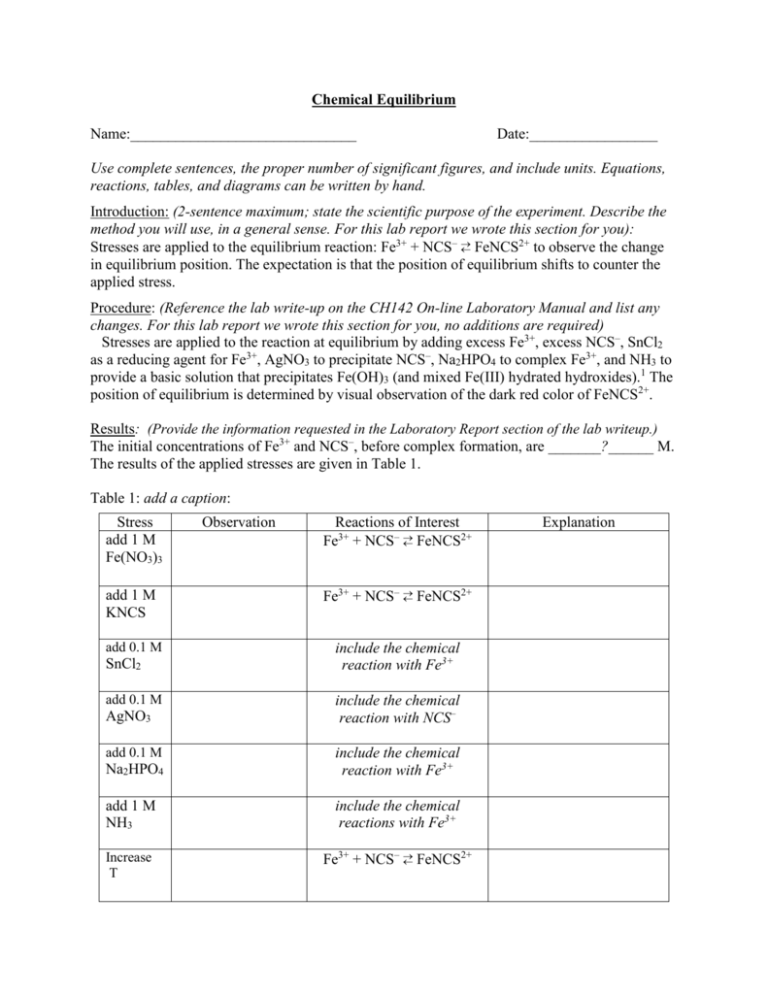
Chemical Equilibrium Name:______________________________ Date:_________________ Use complete sentences, the proper number of significant figures, and include units. Equations, reactions, tables, and diagrams can be written by hand. Introduction: (2-sentence maximum; state the scientific purpose of the experiment. Describe the method you will use, in a general sense. For this lab report we wrote this section for you): 2+ Stresses are applied to the equilibrium reaction: Fe3+ + NCS– FeNCS to observe the change in equilibrium position. The expectation is that the position of equilibrium shifts to counter the applied stress. Procedure: (Reference the lab write-up on the CH142 On-line Laboratory Manual and list any changes. For this lab report we wrote this section for you, no additions are required) Stresses are applied to the reaction at equilibrium by adding excess Fe3+, excess NCS–, SnCl2 as a reducing agent for Fe3+, AgNO3 to precipitate NCS–, Na2HPO4 to complex Fe3+, and NH3 to provide a basic solution that precipitates Fe(OH)3 (and mixed Fe(III) hydrated hydroxides).1 The position of equilibrium is determined by visual observation of the dark red color of FeNCS2+. Results: (Provide the information requested in the Laboratory Report section of the lab writeup.) The initial concentrations of Fe3+ and NCS–, before complex formation, are _______?______ M. The results of the applied stresses are given in Table 1. Table 1: add a caption: Stress add 1 M Fe(NO3)3 add 1 M KNCS add 0.1 M SnCl2 add 0.1 M AgNO3 add 0.1 M Observation Reactions of Interest 2+ Fe3+ + NCS– FeNCS 2+ Fe3+ + NCS– FeNCS include the chemical reaction with Fe3+ include the chemical reaction with NCS– Na2HPO4 include the chemical reaction with Fe3+ add 1 M NH3 include the chemical reactions with Fe3+ Increase T 2+ Fe3+ + NCS– FeNCS Explanation Decrease T 2+ Fe3+ + NCS– FeNCS Based on the shift in equilibrium position with increase and decrease in temperature, the formation of the iron(III) thiocyanate complex is (exothermic, endothermic). Discussion: (You write this section) (a). Purpose accomplished: Restate the purpose of the experiment, but as a completed goal. (b). Write the equilibrium reaction that you are studying (not the reactions that apply stresses involving Sn2+, Ag+, HPO42-, and NH3). (c). Give a general summary statement on the agreement between the observed shifts of the position of equilibrium and the predictions based on LeChatelier’s principle. One to three sentences. (d). Suggest one source of systematic error. Remember that student mistakes are neither random nor systematic errors; student mistakes are just student mistakes. For this experiment examples of systematic errors include errors in the concentrations of the reagents, the volumes of the reagents added, or the ability to judge the change in intensity of the red color of the solutions if the solution starts off too darkly colored. What effect does the source of systematic error have on the final results? (For example, does the systematic error cause an increase or decrease of the observed shift?) (e). To summarize the experiment, answer the following question: how can the outcome of chemical reactions at equilibrium be controlled? Your answer should be one to three concise sentences. Literature Cited: (note the format of this citation, you will be writing the citations for the next lab) 1. “Laboratory 1: Chemical Equilibrium,” General Chemistry Laboratory Manual, CH142, Dept. of Chemistry, Colby College, 2016: “www.colby.edu/chemistry/CH142/lab/CH142Exp1Equilibrium.pdf”, last accessed 2/1/2016. Checklist: Use complete sentences and provide the proper number of significant figures and units. All Figures and Tables must have captions. Captions start with Figure # or Table # and then a concise description of the contents. Refer by number to each figure and table in the body of the text of your report. Acknowledge any data that were not taken by you and your partner (if you had a partner). You can write the captions by hand in black pen if your figures and tables are on attached sheets. Answer all the questions in the Discussion section of the write-up. Remove all the italicized prompts in your final report. The report should then read smoothly.
